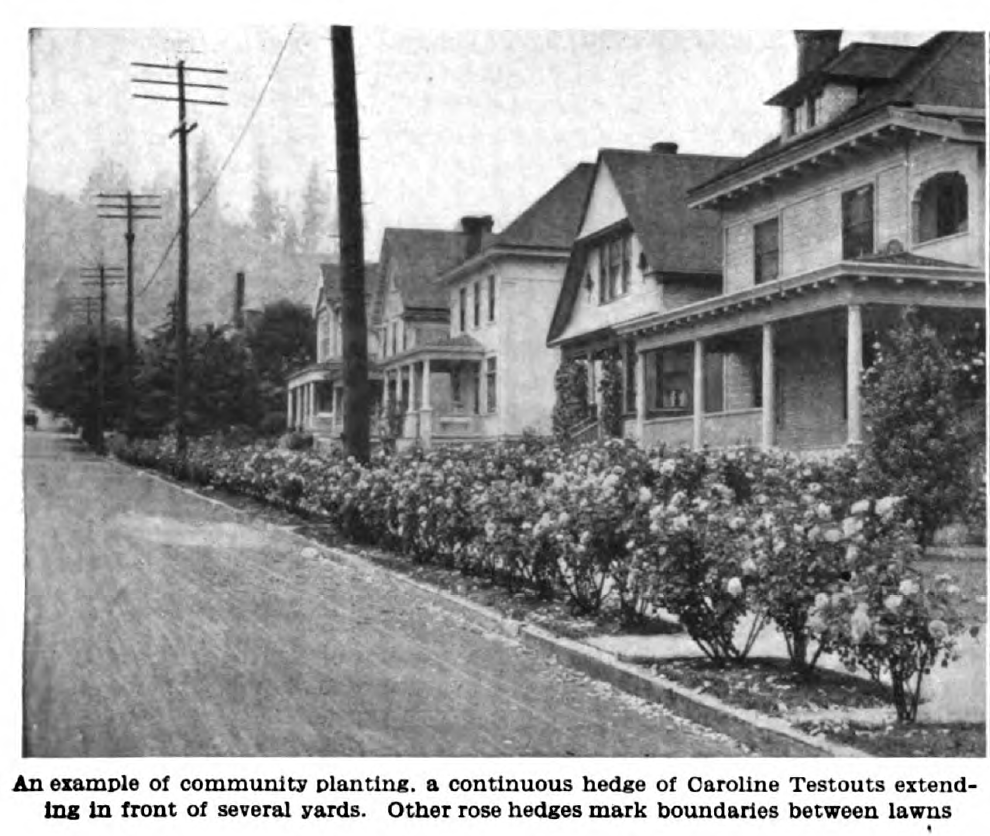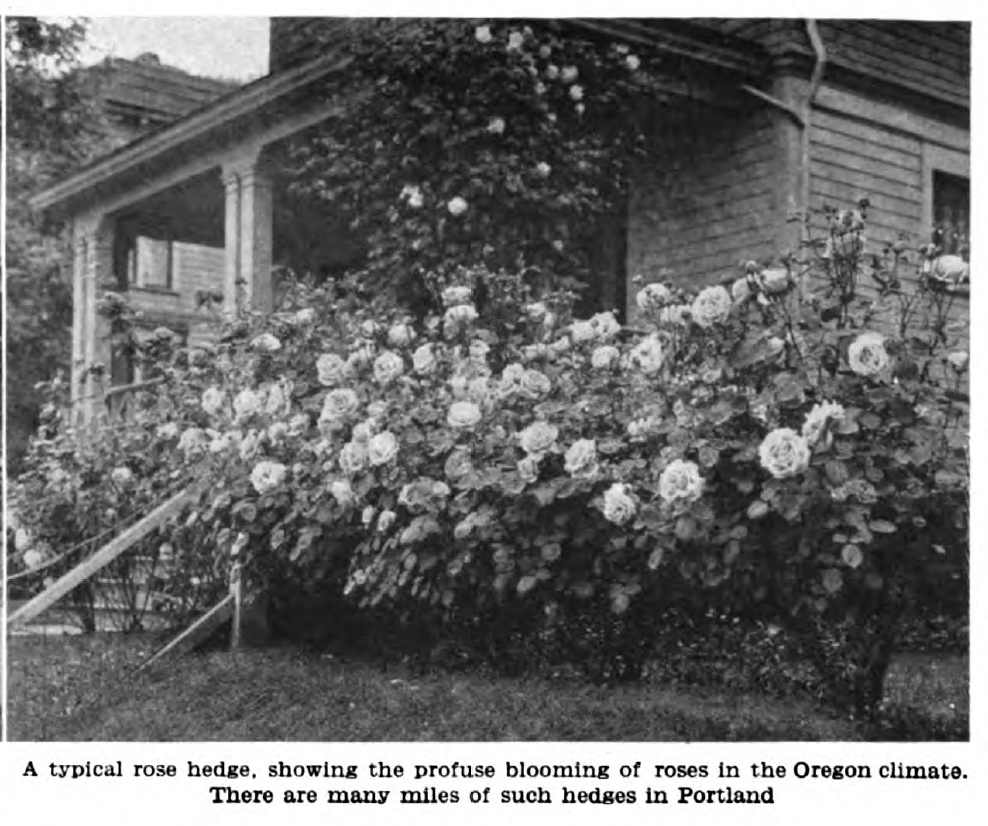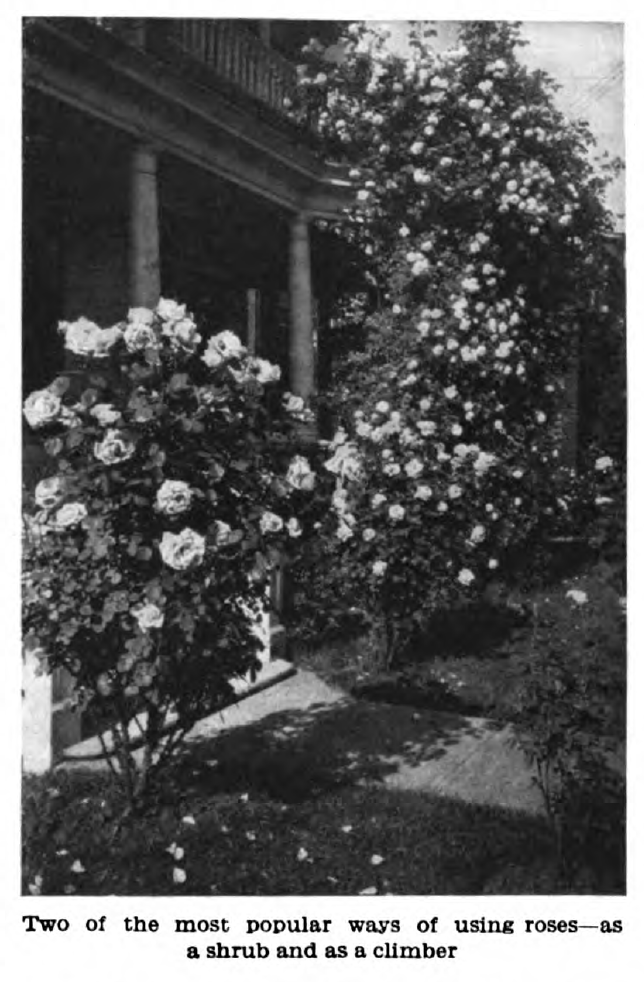Roses worth crossing the continent to see.
Bingham, Kate Stevens. "Roses worth crossing the continent to see." Country Life in America 20, no. 4
(June 15, 1911): 41.
[https://library-projects.providence.edu/rosarium/view?docId=tei/rg0042.xml]

Having lived in Oregon and knowing to what perfection roses attain there, I hastened my trip across the continent in order to be present at the Rose Festival of 1910. This festival, started in 1907, now comes off early in June at Portland—The Rose City.
The week opened with the rose display held by the Oregon Rose Society in the Armory. The interior of the great edifice was converted into a veritable bower of magnificent blooms, relieved by foliage of many shades of green.
It is no exaggeration to say that they were the size of saucers, yes, even breakfast plates. To my mind, such roses alone are worth a journey across the continent just to see. Portland claims to produce the finest roses in the world, excepting it may be those of Lyons, France, and Arenburg, Germany. The marvelous thing about them is that they are all grown in the open and, mostly, by amateurs. The six great classes into which the rose family is divided, namely, Hybrid Perpetual (or Remontants), Hybrid Teas, Teas, Noisettes, Bourbons, and Ramblers, were all represented.
Caroline Testout and La France are said to attain perfection in this climate. Other pink roses, well known to Easterners, were Viscountess Folkstone, Belle Siebricht, and Maman Cochet.
Among the red-hued ones were Prince Camille de Rohan, the darkest of all the red roses, Liberty and Richmond, favorites at the New England rose shows, and Ulrich Brunner which, although a late arrival in Portland, is now become, owing to its perfect development in the Oregon climate, a rival to the pink beauties first mentioned. The American Beauty, General Jacqueminot, and Papa Gontier, were also present but their blooms are here considered inferior to those of many other roses.
Leading the white roses were Kaiserin Augusta Victoria, Margaret Dickson, Madame Plantier, and Frau Karl Druschki, a recent comer, and called the nearest white of any rose in existence.
The glorious, golden-hued flowers of Marechal Niel, with their background of dark, glossy, green leaves, showed off to great advantage amid the other colored roses.
New to me was the pink Irish beauty, Mildred Grant, said to be the finest rose in existence when conditions are favorable; also, John Bright Clark, a red rose, which, though lately come to Oregon, bids fair to outrival La France and Testout in the popular fancy. Dean Hole and Thomas Pemberton were in size and perfection of their blooms, among the most remarkable roses I saw. The former is copper-colored, shading to yellow; the latter a superb pink.
Most of Portland residences have some land about them, which is generally utilized for rose gardens. I noticed many hedges of roses; some of them serve as a boundary of a place; others line the sides of a walk or driveway leading up to a front entrance, and again others, where the street is parked, ornament the outer edge of a sidewalk. Sometimes the bushes are labeled, for educational purposes. A block of land 200 feet square next to one of the public playgrounds of the city, is devoted exclusively to roses.
The favorite rose for hedges is Caroline Testout, but La France, Frau Karl Druschki, and Ulrich Brunner are also employed for this purpose.
Climbing roses are used on the sides of houses, fences, piazzas, pillars, and pergolas. Chief among the white climbers appear to be Mme. Alfred Carrière, Kaiserin Augusta Victoria and Lamarque; among the yellows are Reve D’Or, Gloire de Dijon, William Allen Richardson, and Marechal Niel; while some of the red ones are Reine Marie Henriette and Rambler. A lovely pink climber, the Gainsborough, a sport from Viscountess Folkstone, received its name from Mr. Holman’s remark to the originator, that the blossom reminded him of a young girl in a Gainborough hat.
Rose trees, or standards, are quite prevalent in many gardens. Paul Neyron, Giant of Battles, and other Northwestern favorites are used. Frequently the standards, as well as bushes and climbers, are budded on foreign stock, so as to help the more delicate varieties to withstand untoward conditions, as for instance severe frosts, for occasionally even in this favored climate, the weather goes down to below freezing. Standards are budded to provide them with a sturdy trunk or stem. The stocks used are the Manetti rose, imported from Italy, the European dog brier, and the native brier.
The chief reason why roses flourish so well in Oregon is the climate. The soil is heavy clay, rich in vegetable mould. The climate is even, the mercury seldom below the freezing point in winter or above 70 degrees Fahrenheit in summer. But the important point is the moist and clouded condition of the atmosphere usually prevalent at the great blooming time, late in May and early in June.
Lewis and Clark in their journals mention seeing the native brier rose in Oregon in 1805. The first cultivated variety was brought to the country and planted at Fort Vancouver, six miles from the present site of Portland, in the time of John McGloughlin, the so-called "Father of Oregon." Later the American missionaries who came to Oregon took slips of this first rose, which in consequence came to be known as the Mission. A specimen of the Mission can be seen in Mr. Holman’s garden; it is a pink rose, not particularly pretty. The second variety to emigrate to the Northwest was the old-fashioned Damask, even now almost the sweetest rose in the world. Mr. P. W. Gillette brought it there in 1852 from Ohio.
[Editors’ Note:—A list of varieties which succeed in Oregon, and other facts about rose growing in Portland, the Rose City, appeared in The Garden Magazine, for May, 1910.



